Saturday morning scares: Animation writer Buzz Dixon on the art of creeping out kiddos
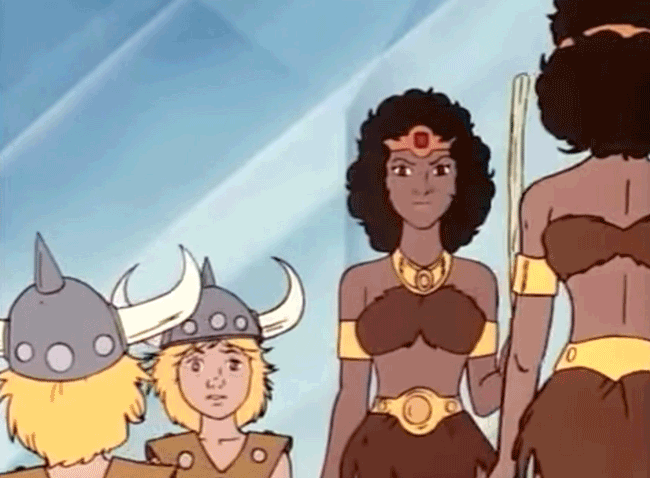
It’s a scene that’s been rattling around in my head since I was 6 years old. Two colorfully garbed youthful warriors are standing in front of a mirror when they rapidly, and unnervingly, start changing: One ages into a withered crone, while the other shrinks to the size of a mewling infant. For years, I couldn’t tell you the episode or even the show that sequence appeared in; it just existed in the recesses of my brain as context-free childhood nightmare fuel. Now it can be told: As a kid, I was scared beyond all logical reason by … an episode of Dungeons & Dragons, the short-lived Saturday morning cartoon based on the eternally popular role-playing game.
Specifically, I was frightened by the ninth episode of the show’s first season, “Quest for the Skeleton Warrior,” which first aired in November 1983, though I saw it a few months later on a scratchy taped-off-TV VHS dub. While not technically a Halloween episode, “Quest” had plenty of scary moments, since the episode’s premise involved the characters — a sextet of kids transported from Earth to the magical D&D realm — confronting their greatest fears while navigating a mystical tower at the behest of the titular Skeleton Warrior. While the group’s stalwart leader, Hank, literally saw his world crumble around him, the brash Eric had the humbling experience of his face suddenly acquiring donkey characteristics, and shy Sheila was left completely and utterly alone. And then there were Diana and Eric, the confident tomboy and baby of the group, respectively. Separated from their friends, they wound up in a room filled with mirrors, where they saw their reflections age in opposite directions: As Diana grew old and withered, Eric reverted to infancy. And then that process repeated itself on their actual flesh as well, in a scene that warped my fragile little mind.
That transformation sequence also guaranteed that “Quest for the Skeleton Warrior” became the only episode of D&D I ever watched, which explains why the show title never came readily to mind until I recently tracked it down on YouTube again. Happily, seeing it again as an adult helped exorcise that particular childhood boogeyman, and it also provided me with the name of the writer responsible for those decades-old nightmares: Buzz Dixon, a veritable auteur in the world of Saturday morning animation, and one who cheerfully admits to trying to push the envelope with what that now-vanished industry would allow during his decade-long tenure.
From the late ’70s to the late ’80s, Dixon either freelanced or served on the writing staffs for such shows as Thundarr the Barbarian, G.I. Joe, InHumanoids, and Bionic Six. And as with D&D, he wrote some of the scarier or more mature episodes of each of those shows, often navigating strictly outlined parameters about what could or could not be shown to impressionable young viewers — like me — on Saturday mornings. As my personal experience proves, he found ways to overcome those limitations. When I sheepishly confess that the de-aging scene from “Quest of the Skeleton Warrior” haunted me for years, he’s entirely sympathetic. “I can understand that. When I was growing up, I would see things that people would not necessarily think of today as being scary, but it left an impression on me.” In this wide-ranging discussion, Dixon lifts the curtain on the creation of his Dungeons & Dragons episode, as well as the Saturday morning do’s and don’ts when it came to horror and violence.
Yahoo TV: How did you initially get involved with writing Saturday morning cartoons?
Buzz Dixon: I was looking for a job as a driver, and I ended up becoming a writer! Just to briefly recap, I had been in the Army, and as I was being discharged in 1978, I applied to USC’s film school and was accepted. But school didn’t start until October, and I was discharged in February. My wife and I moved to Los Angeles, and I started knocking on studio doors to get a job as a driver or in the mailroom, just to get my feet wet. One of the doors I knocked on was Filmation Associates, five minutes after producer Lou Scheimer said, “We need to find another staff writer, and fast!” I had been a newspaper editor and a military journalist, and had a stack of short stories that I had written but not yet sold. So it was one of those cases of being in the right place at the right time. By the time October rolled around, I was making a living writing animation and said, “I can put off going to USC for a year or two.” That year or two became a decade or two.
What were the general standards for the depiction of violence and horror in the world of Saturday morning cartoons?
When I started in the late ’70s, there were already severe restrictions in place in terms of the violence. The networks could not and would not draw a distinction between cartoon violence — which would be Tweety hitting Sylvester with a mallet — and a Scooby-Doo episode where someone gets bonked on the head and knocked out with a frying pan. There is a qualitative difference, because Scooby-Doo at least has the suggestion that it’s occurring in the real world, not in the cartoon world. Parakeets and cats do not pick up skillets and smash one another with them.
In terms of horror, giant monsters were a lot more acceptable than human-sized monsters. And they tended to look goofy because they didn’t want to scare the kids too much. With Thundarr, for example, we were allowed to destroy any non-living thing we could throw at Thundarr. We could send robots after him; we could send a rock monster; we could send clay zombies! We did an episode called “The Brotherhood of Night,” which was about a tribe of werewolves. That was a line we had to walk carefully, because Thundarr could not do anything that would physically harm a werewolf. Conan the Barbarian would have waded into them and there’d be werewolf parts all over the place. But Thundarr had to fight them in a way that meant no permanent harm.
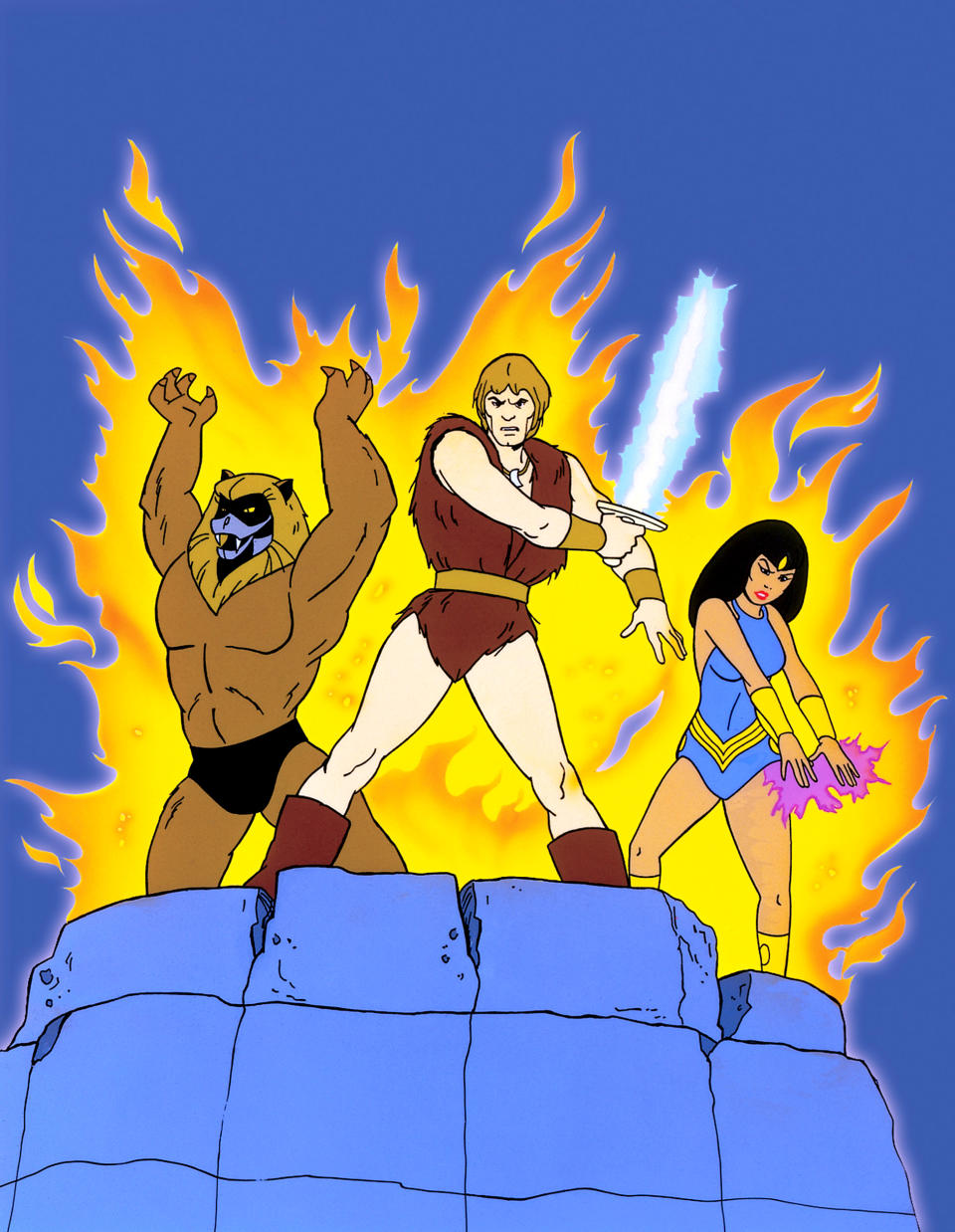
What were some of the do’s and don’ts for writing scarier episodes in particular?
You couldn’t have an overt death threat. For example, it was considered pretty scary to lock somebody in a room. If you did that, there had to be a window they could look out of so that they weren’t trapped in the dark and that there would be some indication that they could get out eventually. If I remember correctly, we also weren’t allowed to tie people up, or if they were tied up in some fashion, it had to be some ridiculous sci-fi device that caught them. Real weapons of any kind were a no-no, and to be honest, I can understand that. You don’t want to have an episode where some guy is slashing away with a real sword, and then some kid goes in the kitchen and gets a carving knife. Then it became a question of, “What is something that kids are anxious about? That would resonate emotionally with them at that level?”
Was “Quest of the Skeleton Warrior” an episode that was assigned to you, or did you pitch this particular story?
I pitched it, if I remember correctly. I’d been asked to contribute to the show, and they said, “Anything that appears in the Dungeons & Dragons game, you can use.” In many cases, that meant that it had to be toned way down, but if it was a monster or an entity or something like that, you could use it. I looked at the game, saw the Skeleton Warrior, and I liked that look.
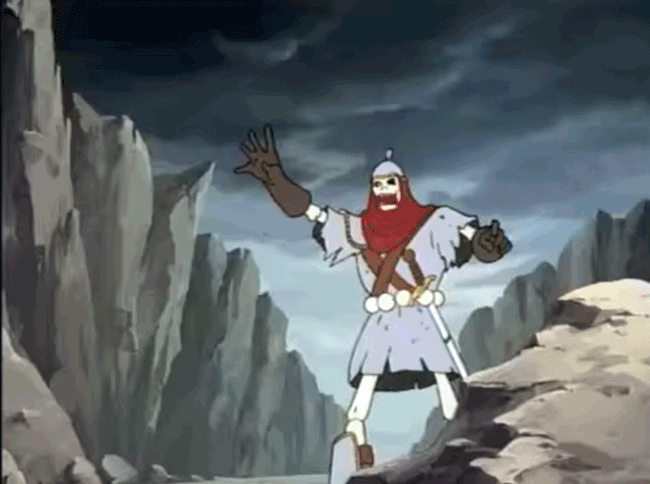
I had also been dissatisfied with the type of Saturday morning cartoon with a bad guy who just acts bad for no rational reason. My favorite example is Super Friends; I know people love Super Friends, but say the Joker steals the Eiffel Tower. Who cares? Outside of the tourist industry, who is that going to impact? The Skeleton Warrior, to me, was a chance to do a character who was a villainous character, but you could understand the reason behind his villainy and what was motivating him. That’s actually a little more scary than the Joker or Lex Luthor being bad. Even kids at that young age understand there’s a right thing to do and a wrong thing to do, and can understand wanting something so badly, they might consider doing the wrong thing.
The episode is centered around the characters facing their greatest fears. How did you decide what those fears would be?
There were certain things I knew we couldn’t do. We couldn’t do fire, obviously, because that’s a very traumatic thing for a lot of people. Anything involving death or mutilation you also couldn’t do on the networks at that time. So it was trying to find something that kids could relate to and, conversely, nobody at standards and practices would go, “Oh, no, you can’t do that.”
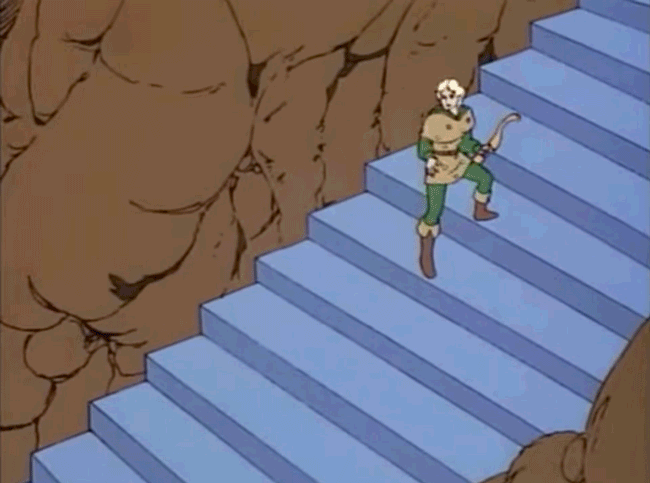
The disappearing staircase is a great idea that falls in those parameters, for example.
Yeah, and that’s something that you can symbolize easily in animation. That was the other thing. It’s pretty hard to explain to a young audience what it’s like to wake up at three in the morning with a sense of existentialist dread. That’s a little difficult to animate! [Laughs] On the other hand, literally seeing your world falling apart around you is something that you can animate, and something that they can grasp fairly easily.
It was Diana and Bobby’s transformation that got to me. Something about seeing them age in opposite directions really unnerved my child brain.
I tried to think of the kind of things that a child looking at it may not be able to verbalize, but would think, “Oh, yeah, I would hate to be even younger and smaller.” The little boy who was the barbarian always wanted to be grown up, and he always felt self-conscious about being the smallest and youngest in the group. So his fear would be to become even smaller, younger, and more helpless.
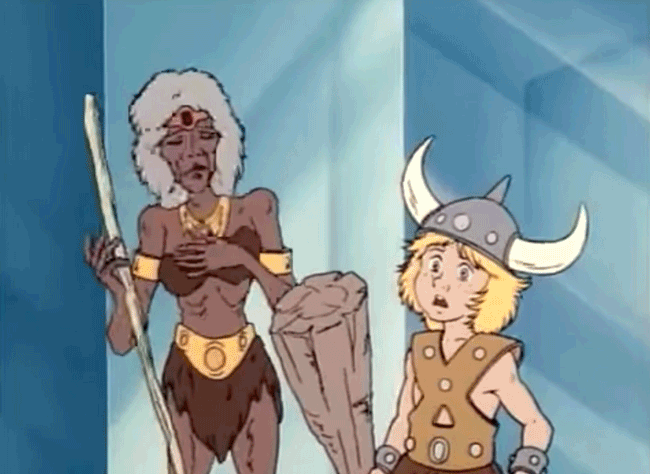
The girl who was getting older was aware of the fact that she was approaching maturity and whatnot. We didn’t want to get too psychological about this, but she wasn’t rushing forward to embrace that, if you follow me. She was kind of happy where she was and a little bit anxious about the responsibilities of growing up, even though she did act maturely. So we pushed it in that direction.
The Pleasure Island transformation scene in Pinocchio always scared me for some of the same reasons; I still have trouble watching it today, to be honest. And this episode has a Pinocchio reference in it when Eric sprouts donkey ears. Was that intentional?
Yeah. You’ve got to understand: My mother was Italian. I saw Pinocchio as a kid, and she said, “You don’t know half the story.” She drags out the real thing, and I was like, “Oh my God!” What’s done in the Disney movie is really lightweight stuff compared to the original Italian illustrations. They had Dante to refer to! The Disney version is disturbing, but it’s cartoony disturbing. The Italian illustrations are going to mess with your mind.
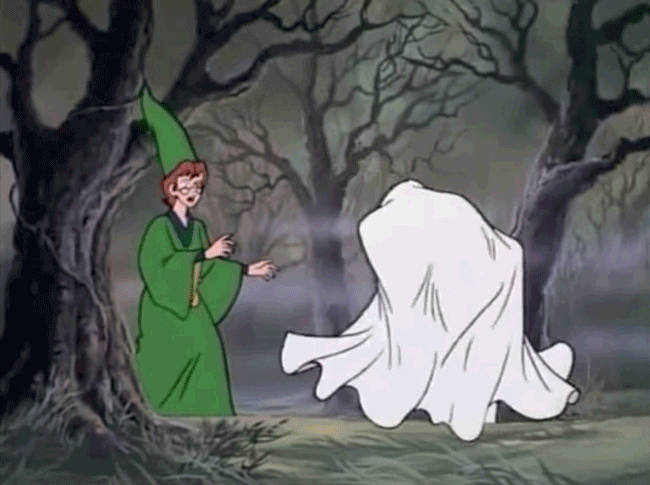
You mentioned earlier that weapons were an issue with many studios, but the D&D kids are each armed with a specific weapon. How did you navigate that with standards and practices?
As I recall, the little boy has a club, and he wasn’t allowed to use the club on a living thing. Now, he could hit the ground and cause an earthquake that knocked people over! Or if a boulder was rolling at him, he could swat it out of the way. But he couldn’t use it as an actual weapon, because, again, you don’t want somebody taking a baseball bat to their kid sister. There was also an archer, and that was a very, very tender issue, because they wanted to make absolutely certain those things were never used as real weapons against living things. Generally, the more magical or fantastic a weapon was, the safer it was to use in a story. Thundarr had a sun sword that’s just a hilt when it’s inert, and when he turns it on, it’s like a lightsaber. You can’t find a weapon like that in your home, so that’s OK for Thundarr to use. Even then, though, he couldn’t use it against a living thing.
Did you intend for “Quest” to be scarier than the average D&D episode?
I was certainly aiming for that. It was a little less action adventure-y and a little more scary. Obviously, when your main antagonist in the story is a skeleton warrior, you’ve got a horrific image right there. You either play into it or you play completely against it. You could do a story about a really nice, sweet skeleton warrior who realizes, “Oh, man, I’m scaring the crap out of everybody.” But that would not be this story, obviously. With this story, I went, “He’s virtually a symbol of death. He looks like Death. Get as close to that as standards and practices will allow.”
How much of the episode were you able to see as it was animated?
It varied from studio to studio, and it varied whether you were a staff writer or a freelancer. With Dungeons & Dragons, I was pretty much a freelancer, and as a result, I wrote the script and handed it in. I don’t believe I ever saw anything until it actually aired. On other hand, when I was at a studio like Ruby-Spears, I’d spend quite a lot of time with the artists, because I wanted to make sure they understood what I was trying to do. And they appreciated the fact that I’d come down and listen to them. They would say, “It’s really difficult to stage something like this,” and I would go back and try to figure out a way of restaging it that would be easier for them.
Were you happy with the finished episode when you saw it? Does it achieve what you set out to do?
For what that show was, I was very happy with the outcome. I thought it worked well, and I think it still works well to this day. If you asked, “In the context of the entire Dungeons & Dragons oeuvre, could you have done something with this basic idea?” Well, yeah, but then it’s an R-rated movie. [Laughs]
As you moved through the industry and worked on different shows, did you always find yourself drawn to pushing the envelope and finding ways to make things scarier? You wrote an episode of InHumanoids that’s pretty intense.
I’ve always been an envelope pusher, but I haven’t always pushed in the direction of horror, because there are a variety of things that interest me and a variety of stories I’d like to tell. Interesting story about InHumanoids: Hasbro canceled the toy line halfway through production on the series. They told us, “We have to complete the series and put it on the air. Basically, we don’t care what you do as long as we don’t get a complaint from the FCC.” We went, “Oh, really?” And we went completely nuts! I did a story where there’s a bunch of teenagers who had been turned into zombies, and they’re walking through the streets chanting, “Kill, kill, kill.” The voice actors got to that part and went, “Whoa, wait. Are we allowed to do this?” We said, “Yeah, yeah. Don’t worry, don’t worry. By the time this comes to anybody’s attention, your checks will have cleared. Don’t worry.”
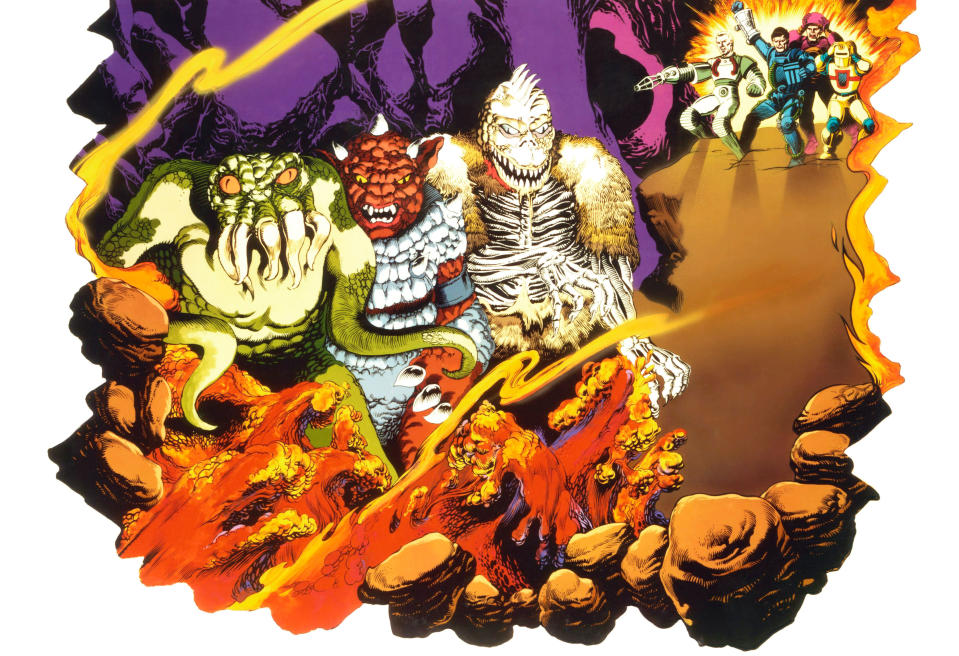
Mind you, at the same time we’re doing InHumanoids, we’re also working on My Little Pony! At that time, we were all what I would call utility infielders. Each of us had a show assigned to us, but we helped one another — we all had input to some degree on every show that was being done by that studio. That fostered a good sense of competition insofar as everybody was striving to top what the other person had done. It reflected in the shows, I think; they stand up better than many other shows that were done at that time.
Were you at all worried thinking about kids at home watching zombies rampaging through the streets saying, “Kill, kill, kill”?
To be very honest with you, no, I wasn’t worried. And the reason I wasn’t worried is that I had been a longtime fan of Japanese animation, so I knew they had been doing far more emotionally intense shows than we had been doing in the United States. By emotionally intense, I mean the stories involved the feelings and the relationships of the characters. What happened in the story had meaning and weight to the characters beyond just the action. That’s in contrast to something like Scooby-Doo, where the kids were never personally at risk from whatever mystery was going on. They just stepped in to help. The Japanese would get the characters involved personally and emotionally in the story, and that actually scared off American networks because they were going, “We don’t want the kids to get worried or anxious.” As a result, all of these cartoons involved the characters coming at a situation from the outside, solving it from the outside, and moving on. It never personally affected them.
Saturday morning cartoons are long gone now. Were you sad to see that era draw to a close?
Looking back on it, we didn’t realize what we were doing at the time with syndication. We thought syndication was just an additional market, and that there would always be Saturday morning. With traditional Saturday morning animation, you created a show, you showed the show to advertisers, and the advertisers decided if they wanted to advertise or not. Even in the ’70s, networks could run any kind of sports programming and get more ad revenue than they could with Saturday morning cartoons. However, the FCC required a certain amount of children’s programming from the networks and from the local stations, and it was just easier to block out Saturday morning. Once the syndicated market came along, stations that were network affiliates would run G.I. Joe and Transformers in their afternoon blocks. Then they’d say, “We’ve shown our prerequisite children’s programming. We don’t need Saturday morning. You can run sports, and we can all make more money that way.”
To be brutally honest, the majority of people were doing this stuff just to collect a paycheck. Very few people were doing it with the thought of, “I want to do something that will matter five, 10, 15 years from now.” Because it was all viewed as very ephemeral. You do it, you put it out there, and they’re going to forget it. Nobody in the late ’70s and early ’80s could anticipate that VHS and then other forms were going to completely revolutionize the way we consume media. If you’re willing to go on YouTube and poke around for 15-20 minutes, I don’t think there’s a TV show from the past that you can’t find.
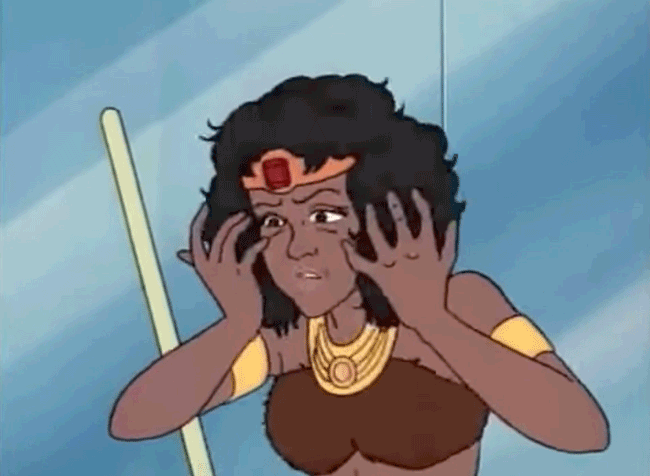
Could you do an episode like “Quest for the Skeleton Warrior” in today’s landscape for TV animation?
I haven’t been involved in animation, hands-on wise, for a couple of decades now, and primarily by choice. I’ve found other mediums more rewarding and more satisfying. I would say this: I have grandchildren, and I’ve seen some of the crap that’s on the Disney Channel. They get away with it because they’ve got a Disney logo on it, but I could not imagine that stuff flying if it wasn’t a Disney program. I mean that just in the sense of rudeness, and the snark level. What I have seen on Disney has not been exceptionally frightening. It’s like the people who are writing these specific shows are all aspiring sitcom writers, and every script they write is an attempt to show somebody, “Hey, I could write a sitcom.” How about you write a script for a 9-to-10-year-old audience that they can appreciate? With Saturday morning cartoons, it was referred to as a ghetto, but the fact was, there was a set of boundaries and rules. You may have chafed against those boundaries and rules, but you knew what they were. If you could find a way of working within them, you could do quite a few episodes that would just be good, solid storytelling.
Dungeons & Dragons can be found on YouTube.
Read more from Yahoo Entertainment:

